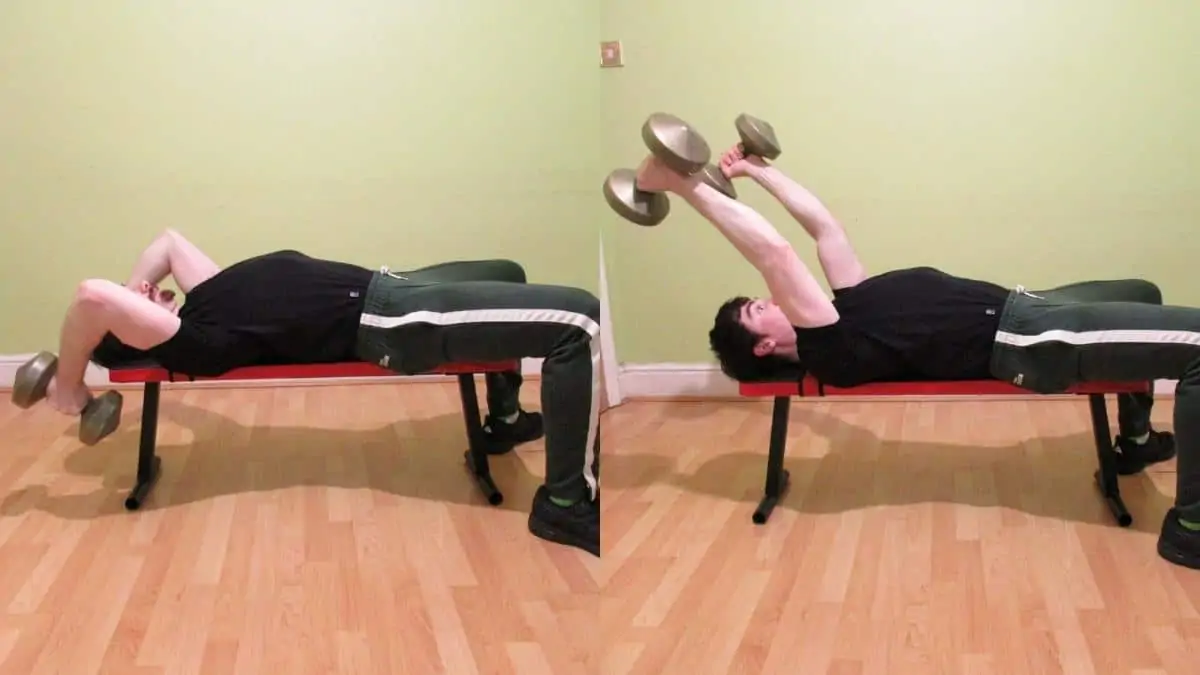Dumbbell skull crushers are an excellent exercise for building and strengthening your triceps because they emphasize the long head, which is by far the largest and strongest tricep head.
Using dumbbells for skull crushers also means lifting each weight separately. As such, DB skull crushers are an ideal isolation exercise for ensuring that your triceps are not only muscular but symmetrical too.
This guide teaches you how to do dumbbell skull crushers with the optimal tricep-building technique and then moves into the benefits, variations, and a series of head-to-head comparisons.
Related: Incline skull crushers│Decline skull crushers
Dumbbell skull crusher exercise details
- Also Known As: Dumbbell nose crushers, DB nose crushers
- Main Muscles: Triceps
- Exercise Type: Strength
- Exercise Mechanics: Isolation
- Difficulty Level: Intermediate
- Equipment Needed: Dumbbells, weight bench
How to do skull crushers with dumbbells

- Grab a pair of dumbbells with a neutral grip and then lie on a weight bench.
- Press the dumbbells up so that they’re directly over the end of the weight bench.
- Lower the dumbbells behind your head by breaking at your elbows and moving your shoulders backward.
- Keep going until you feel a huge stretch in the long (inner) head of your triceps.
- Reverse the movement by extending your shoulders forward and then extending your elbows.
- Flex your triceps as your elbows reach full lockout.
- Repeat for 3-5 sets of 10-20 reps.
Dumbbell skull crusher benefits
The DB skull crusher is an exercise that just about anyone can benefit from because it caters to such a wide variety of goals: toned triceps, massive arms, stronger bench press—the list goes on.
Symmetrical triceps
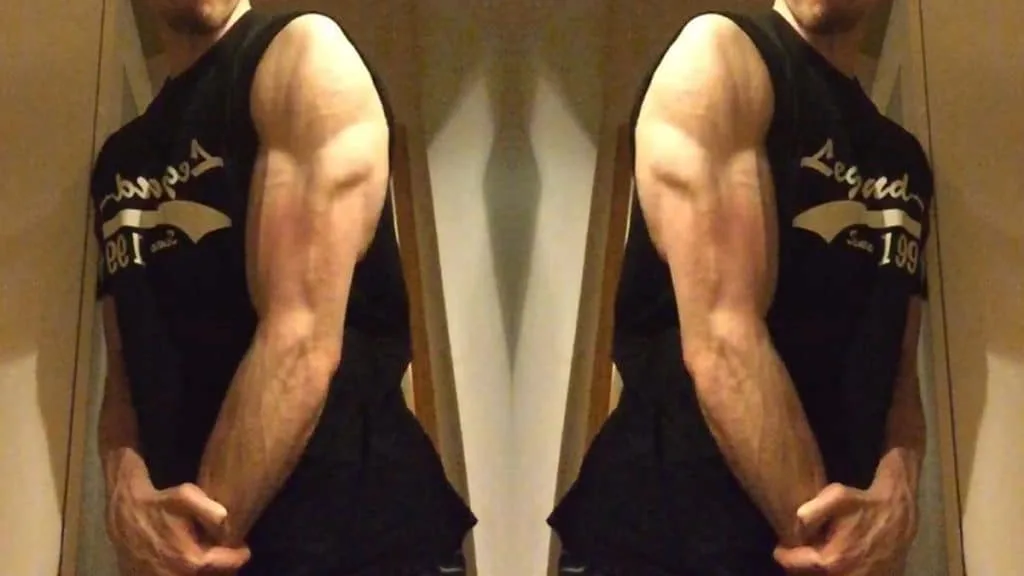
Performing skull crushers dumbbell style entails lifting each weight independently. Although this inevitably means lifting less weight than on the barbell version, it also means that both of your triceps will be receiving roughly equal stimulation and thus growing at similar rates.
The end result for you is more proportional upper arms and an aesthetic upper body because using dumbbells minimizes the chance of you developing any muscular imbalances.
Symmetry is of paramount importance if you’re a physique athlete because competitions are increasingly becoming judged on the overall appearance of your physique, not just the size of your muscles.
The downside of DB tricep exercises, of course, is that it’s harder to gain strength quickly because you can’t microload dumbbells in the same way that you can add fractional plates to either side of a barbell.
Bigger upper arms
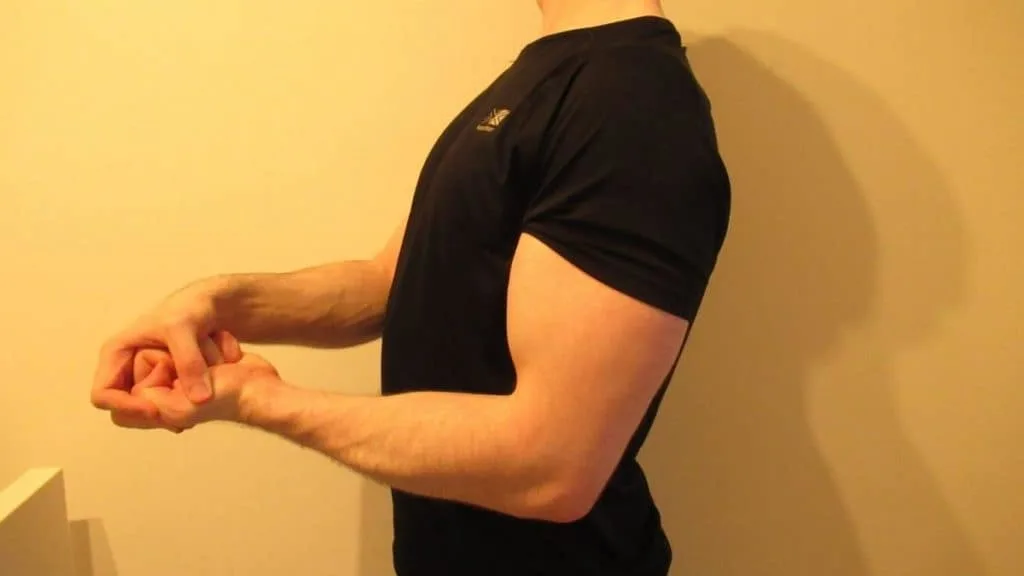
Since the lying dumbbell skull crusher trains the triceps, which is the muscle that accounts for two-thirds of your upper arm mass, it’s the ideal muscle-building movement for bulking up your arms.
However, dumbbell skullcrushers are made yet more effective by the fact that they target the long head of the triceps (of course, they work the lateral and medial head as well).
The long head, it’s widely believed, makes up two-thirds of your triceps mass. So if you want big arms and formidable triceps strength, then the long head of the triceps is the region of your arms that you need to prioritize.
Making your triceps bigger via DB skullcrushers will help you to fill out your t-shirt sleeves and will drastically improve the thickness of your arms when viewed from the side and especially when viewed from the back.
Stronger press lockout

The triceps are a crucial muscle group in any compound pressing exercise because they’re responsible for locking out the weight.
So if you often struggle to move the bar explosively during the final phase of the rep, you may have underdeveloped triceps. In which case, DB skull crushers can help by improving your elbow extension strength.
Similarly, if the bar is lopsided while you’re pressing, then that’s an indication that you have muscular imbalances, a discrepancy that you can improve by training your triceps with dumbbells.
A strong lockout is of particular importance if you’re a powerlifter because it helps you to set new bench press PRs and finish on the podium at your meet.
On the other hand, if you mainly train for hypertrophy, developing a stronger lockout is still beneficial because it’ll help you to overload your muscles with heavier resistance, which in turn will make them grow larger.
Dumbbell skull crusher variations
We’ve included guides to four additional dumbbell skull crusher variations so that you can try multiple exercises and see which version your triceps respond best to.
In addition, you can also try these other types of skull crushers if you want to work your triceps from other angles or with different equipment.
- Cable skull crushers
- Kettlebell skull crusher
- Plate skull crushers
- Resistance band skull crushers
- Smith machine skull crushers
Alternating dumbbell skull crushers

The alternating skull crusher is very similar to the standard DB skull crusher because both exercises have the same technique. The difference is, of course, that in the alternating version, you’re lifting the weights in succession rather than simultaneously.
Performing the skull crusher with dumbbells in an alternating fashion enables you to achieve more reps per set because each of your triceps gets a short rest while the other side is working.
This brief recovery period is made yet more beneficial because the triceps are a fast-twitch muscle group.
As such, they have a very limited capacity for endurance.
Therefore, by taking that short rest, you’re giving your triceps a chance to recover so that they’ll be fresher and stronger by the time that their next rep rolls around and thus able to continue working for longer.
Floor dumbbell skull crushers
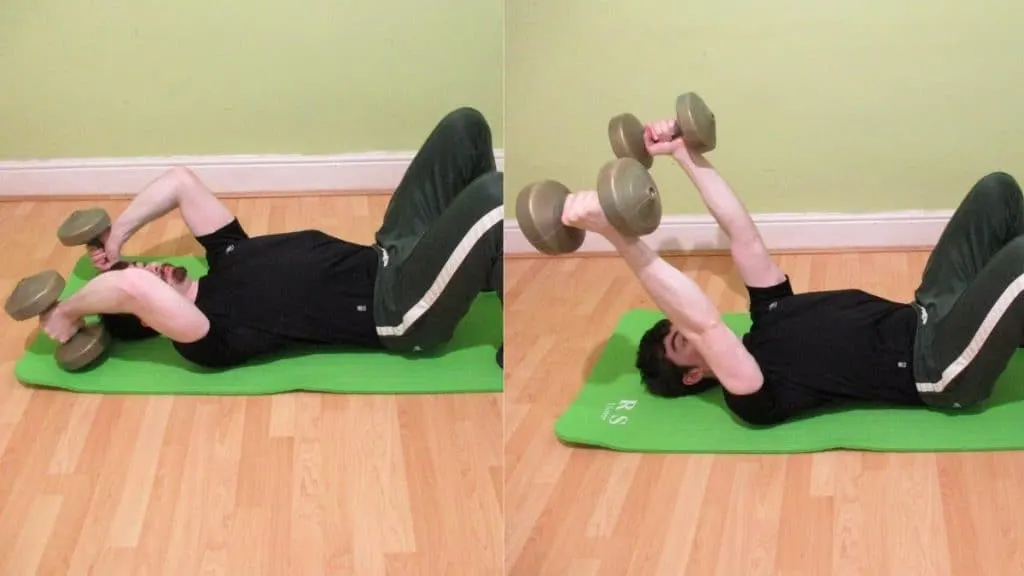
If you train at home or if all the benches are taken at the gym, then floor skull crushers are your best bet.
On the one hand, doing the DB skullcrusher on the floor is better than performing it on a bench because it’s easier to standardize your form by touching the weights to the ground on every rep to ensure that you’re always using a full range of motion.
With the bench version, you have to rely on the intensity of the tricep stretch to ascertain whether you performed a complete repetition or not. As such, if you’re an inexperienced lifter, it can be hard to work out whether you’re actually getting stronger or just using a progressively smaller range of motion in order to lift heavier weights.
On the other hand, performing the lying dumbbell skull crusher on the floor may arbitrarily reduce your range of motion, especially if you have long arms.
This is something you want to avoid if you’re training for tricep hypertrophy because if the weight hits the floor before you achieve a full stretch, then the long head of your triceps won’t receive optimal stimulation, which means that you’ll be leaving a lot of muscle growth on the table.
Pronated dumbbell skull crushers
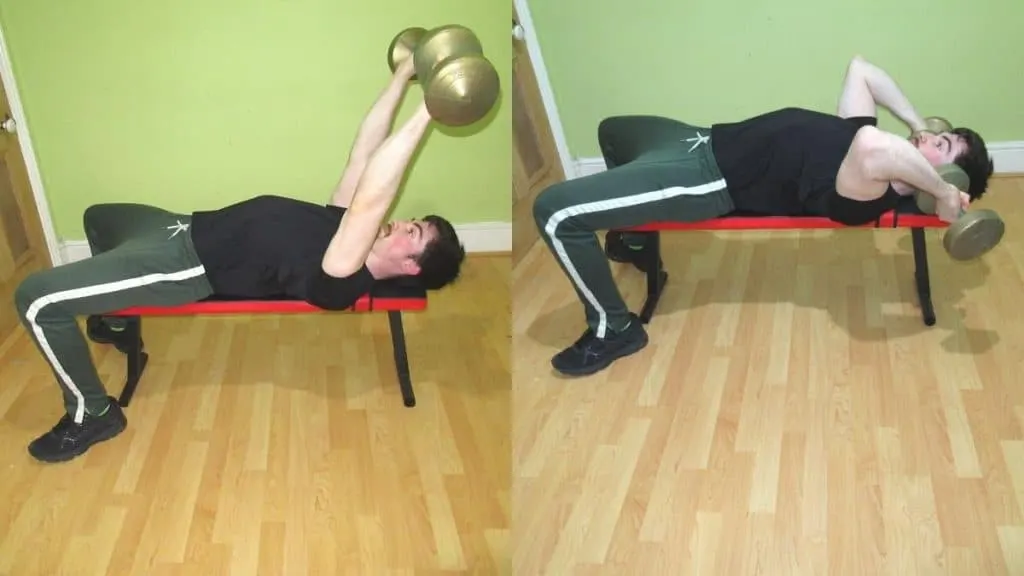
The pronated skull crusher is strikingly similar to the standard dumbbell skull crusher and is, in fact, identical until the final few inches of movement.
Rather than locking out your elbows with your hands in a neutral position, you’re going to finish the rep by rotating your hands from the neutral starting position into a pronated position.
Some lifters believe that this small pronation intensifies the peak contraction.
If that’s the case for you, then, by all means, perform dumbbell skull crushers with wrist pronation.
However, just remember that DB skull crushers are an effective mass-builder precisely because they place the long head of the triceps under a tremendous stretch.
If you want to make the contraction more intense, then attach bands to your dumbbells. A small amount of pronation won’t make much difference because triceps recruitment isn’t affected in any way by your wrist position. [1]
So if you feel a stronger contraction while pronating your wrists, then it’s likely either in your head or simply as a result of you squeezing your triceps more forcefully in an attempt to take advantage of this supposedly “effective” pronation.
One arm dumbbell skull crushers

If you truly want your triceps to be as symmetrical as possible, then one arm skull crushers are your best bet because the exercise is unilateral.
This means that you perform all of your reps for one arm before moving onto your other arm.
The benefit of this approach is that you’ll likely be a bit stronger since your brain only has to focus on moving one limb at a time. Therefore, your central nervous system can dedicate every ounce of its strength to working one particular tricep muscle rather than splitting its resources across two arms.
The downside, of course, is that your sets will take roughly twice as long since you’re training each arm separately. So considering that regular dumbbell skull crushers are already pretty good for minimizing tricep size asymmetries, it might not be worth your time to perform skull crushers in a completely unilaterally fashion, especially if you’re pressed for time. [2]
Dumbbell skull crusher comparison
If you’ve ever wondered how dumbbell skullcrushers compare to the barbell and EZ versions of the exercise, these comparisons are for you.
Dumbbell skull crushers vs barbell skull crushers
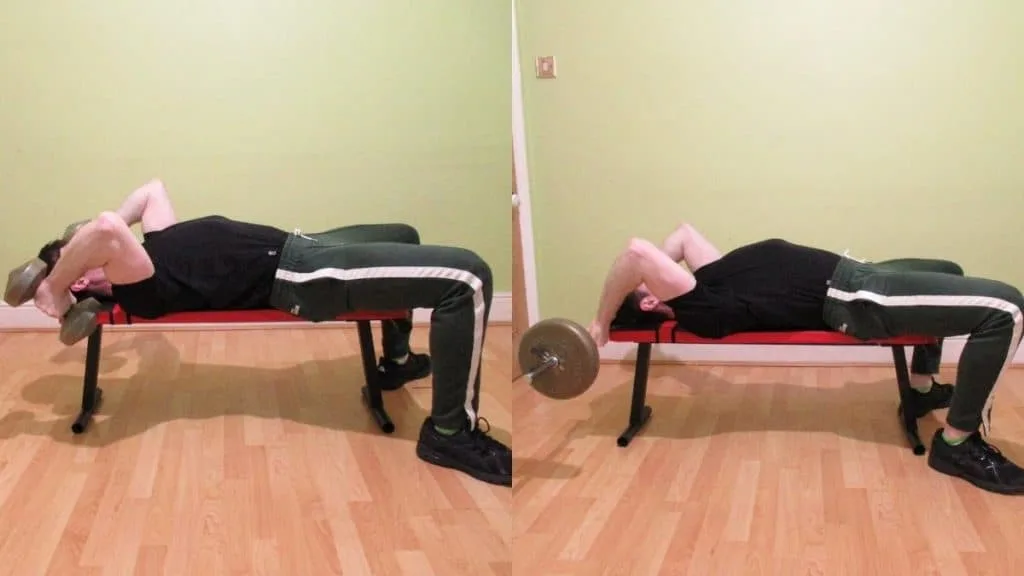
Barbell skull crushers enable you to lift heavier weights and thus overload your triceps with more resistance than the dumbbell skullcrusher because they require less stabilization.
You can also gain strength at a faster rate with the barbell version because barbells are naturally very easy to microload with small or even fractional weight plates.
With dumbbells, on the other hand, the increments can often be 2.5lbs or 5lbs per side once you get past a certain point. The good news is that some gyms have dumbbells (especially the lighter ones) that ascend in very manageable 1-2lb increments, which is ideal for an isolation exercise like dumbbell nose crushers.
DB tricep skull crushers are better than the barbell variation for preventing size asymmetries because they force you to move each arm independently. This isolateral lifting motion ensures that both of your triceps are receiving relatively equal stimulation (though you may still have a stronger mind-muscle connection with your dominant arm) and are thus growing more or less in proportion.
Dumbbell vs EZ bar skull crushers
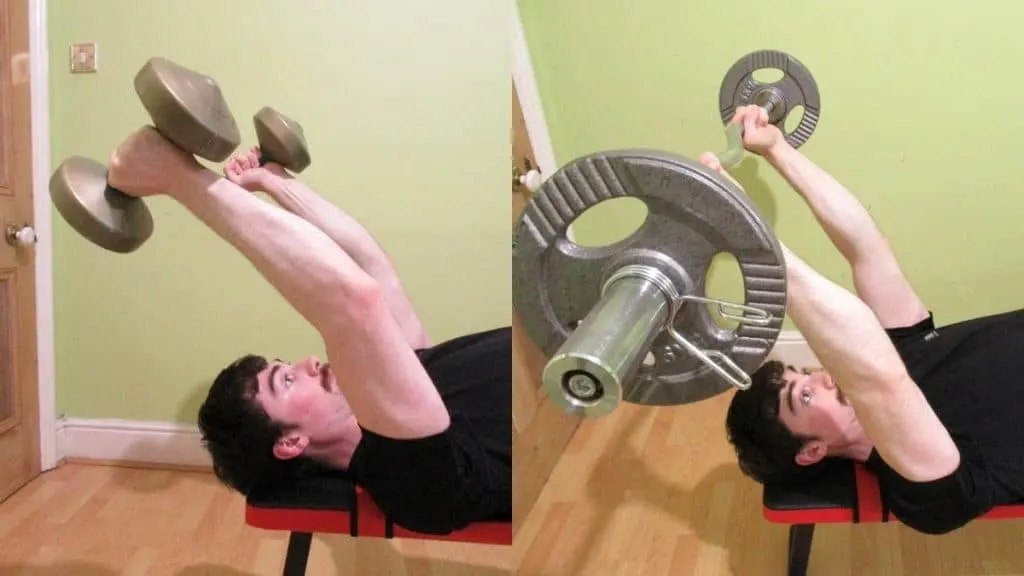
Like the barbell version, the EZ bar skull crusher is better than the DB skull crusher for overloading your triceps because it enables you to lift heavier poundages.
EZ bars also have wrist-friendly semi-pronated grips so that you don’t run into any discomfort as you gain strength. Since you perform the dumbbell variation with a neutral grip, it’s on a par with EZ skull crushers in the safety department.
Of course, you can more easily prevent muscular imbalances by using dumbbells. But you won’t be able to give your triceps the same overload as you’d be able to with an easy curl bar. So, for this reason, you should make the EZ bar your skull crusher training tool of choice if you’re in pursuit of maximum triceps mass.
Read More: Reverse grip skull crushers│DB kickbacks vs DB skullcrusher
Conclusion: How effective are DB skull crushers for building the triceps?
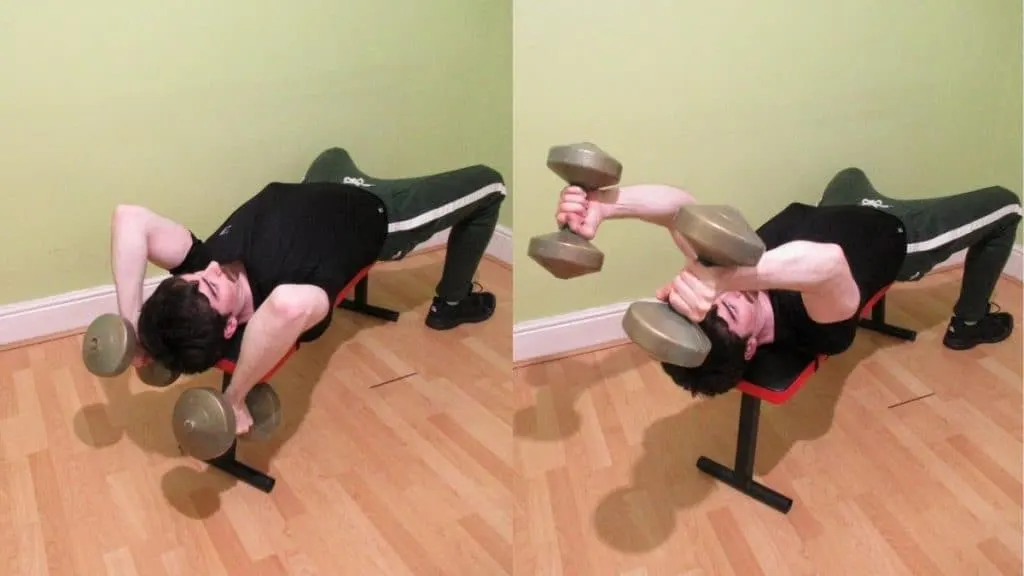
The lying dumbbell skull crusher trains all three heads of the triceps and gives specific emphasis to the largest of these heads: the long head. So if you want to increase the size of your upper arms (the triceps account for two-thirds of your upper arm mass, remember?), then you should definitely include dumbbell skull crushers in your routine.
Unlike the barbell version, DB skull crushers help to limit tricep size asymmetries by having you lift each weight independently. [3] So it’s not like your stronger side can assist your weaker arm because your dominant side is already preoccupied with holding and lifting its own dumbbell. As such, dumbbell skullcrushers are an excellent exercise for sculpting symmetrical (and muscular) triceps.
Perform 3-5 sets of 10-20 reps 1-2 times per week. Since some people experience elbow pain from skull crushers, you’re best off sticking to higher reps so that you don’t put too much stress on your elbows.
And besides, moderate to higher reps are easier to recover from than low reps (so you can train your triceps more frequently), and they also enable you to accumulate sufficient training volume quicker, which is the primary driver of hypertrophy.
References
- Kholinne, E., Zulkarnain, R. F., Sun, Y. C., Lim, S., Chun, J. M., & Jeon, I. H. (2018). The different role of each head of the triceps brachii muscle in elbow extension. Acta Orthopaedica et Traumatologica Turcica, 52(3), 201–205. https://doi.org/10.1016/j.aott.2018.02.005
- Iversen, V. M., Norum, M., Schoenfeld, B. J., & Fimland, M. S. (2021). No Time to Lift? Designing Time-Efficient Training Programs for Strength and Hypertrophy: A Narrative Review. Sports Medicine. Published. https://doi.org/10.1007/s40279-021-01490-1
- Kim, T., Kil, S., Chung, J., Moon, J., & Oh, E. (2015). Effects of specific muscle imbalance improvement training on the balance ability in elite fencers. Journal of Physical Therapy Science, 27(5), 1589–1592. https://doi.org/10.1589/jpts.27.1589

